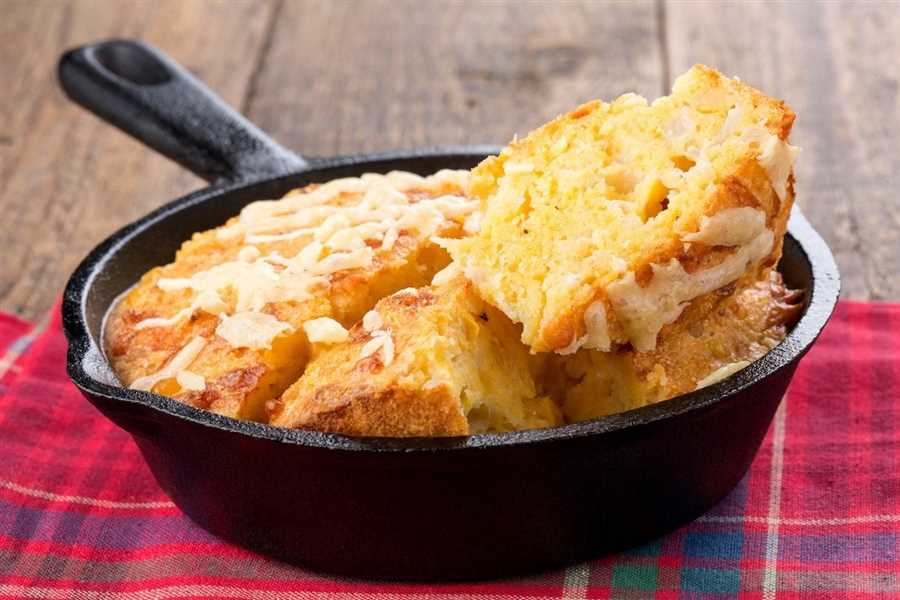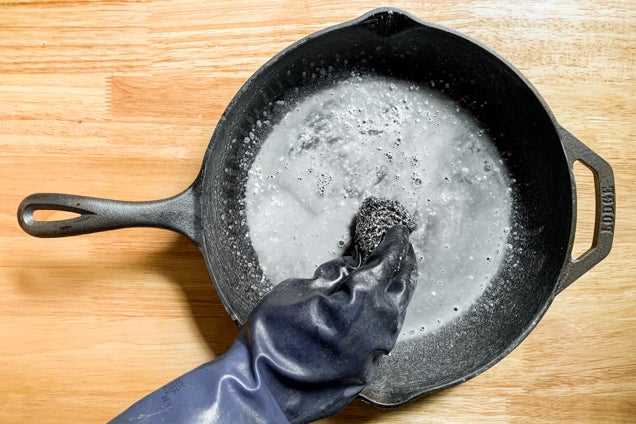







When it comes to cooking with cast iron skillets, there is often confusion about whether or not to use cooking spray. Some people swear by it, while others say it’s a big no-no. So, do you spray a cast iron skillet before cooking?
The answer actually depends on who you ask. Some experts and seasoned cast iron users recommend using cooking spray to help prevent food from sticking to the skillet. They believe that a light coating of cooking spray can create a barrier between the food and the skillet, making it easier to flip and remove the cooked food.
However, there is another camp that believes cooking spray can actually damage the seasoning on a cast iron skillet. Seasoning refers to the baked-on layer of oils and fats that give the skillet its non-stick properties. They argue that cooking spray can build up on the skillet, creating a sticky residue that is difficult to remove and can ruin the seasoning over time.
So, what’s the best course of action? If you’re new to using a cast iron skillet, it may be best to err on the side of caution and avoid using cooking spray. Instead, focus on properly seasoning your skillet and using good cooking techniques, such as preheating the skillet and using enough fat or oil to prevent sticking. As you become more experienced with your skillet, you can experiment with using cooking spray and see if it works for you.
What is the Best Way to Season a Cast Iron Skillet?

Seasoning a cast iron skillet is essential to create a non-stick surface and prevent rust. The process involves creating a layer of polymerized oil on the surface of the skillet, which improves its performance and longevity.
Here is a step-by-step guide on how to season a cast iron skillet:
| Step 1: | Clean the skillet thoroughly. Use hot water and a stiff brush to remove any residue. Avoid using soap as it can strip away the seasoning. |
| Step 2: | Dry the skillet completely. You can towel dry it, or place it on a stovetop over low heat to evaporate any remaining moisture. |
| Step 3: | Apply a thin layer of oil to the skillet. Use a high-smoke point oil like vegetable oil, corn oil, or flaxseed oil. Make sure to cover the entire surface, including the handle. |
| Step 4: | Preheat your oven to 350°F (175°C). Place a sheet of aluminum foil at the bottom of the oven to catch any drips. |
| Step 5: | Put the oiled skillet upside down on the top rack of the oven. This allows any excess oil to drip off. Place a baking sheet or foil on the bottom rack to catch any drips. |
| Step 6: | Bake the skillet for one hour. This process will help the oil bond with the iron, creating a durable seasoning. |
| Step 7: | Turn off the oven and let the skillet cool down completely before removing it. |
| Step 8: | Repeat the seasoning process if desired. Some people prefer to repeat the process a few times to build up a thick seasoning layer. |
| Step 9: | After each use, clean the skillet with hot water and a brush. Avoid using soap and abrasive scrubbers. Dry the skillet thoroughly and apply a thin layer of oil to maintain the seasoning. |
Following these steps will help you achieve a well-seasoned cast iron skillet that can last for generations with proper care and maintenance.
The Importance of Seasoning

Seasoning a cast iron skillet is vital to maintaining its non-stick properties and extending its lifespan. When a cast iron skillet is properly seasoned, it develops a natural, protective layer that prevents food from sticking and protects the skillet from rusting. Here are a few reasons why seasoning is important:
Enhanced Non-stick Properties: Seasoning creates a smooth and shiny cooking surface that helps prevent food from sticking. This natural non-stick surface makes it easier to cook delicate foods like eggs and pancakes without the need for excessive oil or butter.
Improved Flavour: Over time, the seasoning layer builds up and enhances the flavor of the food cooked in the cast iron skillet. The oils used for seasoning can add depth and richness to the dishes, resulting in a more flavorful meal.
Rust Prevention: Seasoning forms a protective layer on the cast iron skillet, preventing moisture from coming into contact with the iron and causing rust. It acts as a barrier, keeping the skillet in excellent condition and prolonging its lifespan.
Easier Cleaning: A properly seasoned cast iron skillet is easier to clean, as the seasoned layer helps to prevent food from sticking to the surface. In most cases, a simple wipe with a paper towel or a gentle scrub with a brush will suffice.
Longevity: Regularly seasoning your cast iron skillet will help extend its lifespan. The well-maintained seasoning layer prevents rust and maintains the skillet’s non-stick properties, ensuring that it will serve you well for many years to come.
How to Season a Cast Iron Skillet:
To season a cast iron skillet, start by washing it with mild soap and warm water to remove any manufacturing residue. Thoroughly dry the skillet, and then apply a thin layer of vegetable oil or flaxseed oil to the entire skillet, including the handle. Place the skillet in an oven preheated to a specific temperature (around 375°F or 190°C) and bake it for about an hour. After baking, let the skillet cool in the oven before using or storing it.
Remember, seasoning is an ongoing process. As you continue to cook with your cast iron skillet, the seasoning layer will gradually build up and improve, enhancing the skillet’s performance over time.
Step-by-Step Guide to Seasoning a Cast Iron Skillet
Seasoning a cast iron skillet is essential for creating a non-stick surface and preventing rust. Follow these steps to properly season your cast iron skillet:
Step 1: Clean the skillet
Before seasoning your cast iron skillet, make sure it is clean. Use hot water and a stiff brush to scrub away any food particles or residue. Avoid using soap, as it can remove the skillet’s seasoning.
Step 2: Dry the skillet
Thoroughly dry the skillet with a clean towel or by placing it over low heat on the stove. It is crucial to remove all moisture to prevent rusting.
Step 3: Apply a thin layer of oil
Using a paper towel or clean cloth, apply a thin layer of oil to the entire surface of the skillet. Common oils for seasoning cast iron include vegetable oil, canola oil, or flaxseed oil.
Step 4: Remove excess oil
After applying the oil, use a clean paper towel or cloth to remove any excess oil from the skillet. The goal is to create a very thin and even layer of oil on the surface.
Step 5: Bake the skillet
Place the skillet upside down on the center rack of your oven to catch any drips. Preheat the oven to 350°F (175°C), and bake the skillet for one hour. This process will allow the oil to penetrate and bond with the skillet’s surface.
Step 6: Let it cool
After baking, turn off the oven and allow the skillet to cool completely inside the oven. This gradual cooling will help create a more durable seasoning.
Step 7: Repeat the process
For the best results, repeat the seasoning process multiple times. This will help develop a stronger and smoother seasoning layer on your cast iron skillet.
Following these steps will ensure your cast iron skillet is properly seasoned and ready for cooking delicious meals!
How to Maintain Seasoning
Maintaining the seasoning on your cast iron skillet is essential to keep it in optimal condition for cooking. Here are some tips to help you maintain the seasoning:
1. Clean it properly: After each use, clean your cast iron skillet with hot water and a gentle brush or sponge. Avoid using soap, as it can strip away the seasoning. If there are stuck-on food particles, you can use a small amount of salt to scrub them away.
2. Dry it thoroughly: After cleaning, make sure to dry the skillet thoroughly to prevent rusting. Use a cloth or paper towel to remove any excess moisture, and then place it on the stovetop over low heat for a few minutes to ensure it is completely dry.
3. Apply a thin layer of oil: To maintain the seasoning, it is recommended to apply a thin layer of oil after each use. You can use a high smoke point oil, such as vegetable oil or flaxseed oil. Gently rub the oil all over the skillet, including the handle and exterior, to prevent rusting and maintain the non-stick surface.
4. Store it properly: When storing your cast iron skillet, make sure it is completely dry and apply a thin layer of oil to prevent rusting. Store it in a cool, dry place to avoid any moisture buildup.
5. Avoid acidic foods: Acidic foods, such as tomatoes or citrus fruits, can strip away the seasoning on your cast iron skillet. Try to avoid cooking highly acidic foods in your skillet or use a well-established seasoned skillet for such dishes.
6. Avoid excessive heat: Excessive heat can damage the seasoning on your cast iron skillet. Avoid using high heat settings and let the skillet heat up gradually to prevent the seasoning from deteriorating.
7. Re-season when necessary: If you notice that the seasoning on your cast iron skillet is starting to wear off or if it becomes rusty, it may be time to re-season it. To re-season, simply follow the seasoning process again by applying a thin layer of oil and baking it in the oven.
By following these tips, you can maintain the seasoning on your cast iron skillet and enjoy its non-stick properties and excellent heat retention for years to come.
Questions and answers
Should I spray a cast iron skillet before cooking?
No, it is not recommended to spray a cast iron skillet before cooking. Cast iron skillets are seasoned to create a natural non-stick surface. Instead of spraying, you can preheat the skillet, add a small amount of oil or fat, and spread it evenly using a paper towel or brush.
What should I do before cooking with a cast iron skillet?
Before cooking with a cast iron skillet, it is important to preheat the skillet on medium heat. Once it is hot, you can add a small amount of oil or fat and spread it evenly across the surface using a paper towel or brush. This will help create a natural non-stick surface and enhance the flavor of your food.
Can I use cooking spray on a cast iron skillet?
No, it is not recommended to use cooking spray on a cast iron skillet. Cooking sprays often contain additives and chemicals that can damage the seasoning of the skillet. It is best to use a small amount of oil or fat and spread it evenly across the surface before cooking.
Why is it important to season a cast iron skillet?
Seasoning a cast iron skillet is important because it creates a natural non-stick surface that makes cooking and cleaning easier. Seasoning involves coating the skillet with a layer of oil or fat and baking it at a high temperature. This process helps to prevent rust, improve the skillet’s heat retention, and enhance the flavor of the food.








